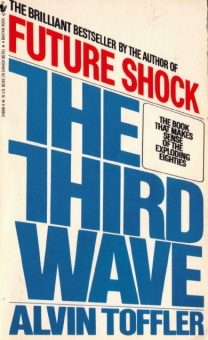THE THIRD WAVE
THE FUTURE OF TIME
Each emerging civilization brings with it not merely changes in how people handle time in daily life but also changes in their mental maps of time. The Third Wave is redrawing these temporal maps.
Second Wave civilization, from Newton on, assumed that time ran along a single line from the mists of the past into the most distant future. It pictured time as absolute, uniform throughout all parts of the universe, and independent of matter and space. It assumed that each moment, or chunk of tune, was the same as the next.
Today, according to John Gribbin, an astrophysicist-turned-science-writer, “Sober scientists with impeccable academic credentials and years of research experience calmly inform us that. . . time isn’t something that flows inexorably forward at the steady pace indicated by our clocks and calendars, but that it can be warped and distorted in nature, with the end product being different depending on just where you are measuring it from. At the ultimate extreme, supercol-lapsed objects—black holes—can negate time altogether, making it stand still in their vicinity.”
By the turn of the century Einstein had already proved that time could be compressed and stretched, and had dynamited the notion that time is absolute. He put forth the now classic case of the two observers and the railroad track, which went more or less like this:
A man standing alongside a railroad track sees two bolts of lightning strike at the same time—one at the far north end of the track, the other at the south. The observer is mid-Way between the two. A second fellow is sitting in a high-speed train rocketing northward along the track. As he passes the observer outside he, too, sees the bolts of lightning. But to him the two flashes do not appear as simultaneous.Because the train is speeding him away from one and toward the other, the light from one reaches him sooner than the light from the other. To the man on the moving train it appears that the northern flash occurs first.
While in daily life the distances are so small and the speed of light so fast that the difference would be unnoticeable, the example dramatized Einstein’s point: that the chronological order of events—what comes first, second, or later in time—depends upon the velocity of the observer. Time is not absolute, but relative.
297
Pages: 1 2 3 4 5 6 7 8 9 10 11 12 13 14 15 16 17 18 19 20 21 22 23 24 25 26 27 28 29 30 31 32 33 34 35 36 37 38 39 40 41 42 43 44 45 46 47 48 49 50 51 52 53 54 55 56 57 58 59 60 61 62 63 64 65 66 67 68 69 70 71 72 73 74 75 76 77 78 79 80 81 82 83 84 85 86 87 88 89 90 91 92 93 94 95 96 97 98 99 100 101 102 103 104 105 106 107 108 109 110 111 112 113 114 115 116 117 118 119 120 121 122 123 124 125 126 127 128 129 130 131 132 133 134 135 136 137 138 139 140 141 142 143 144 145 146 147 148 149 150 151 152 153 154 155 156 157 158 159 160 161 162 163 164 165 166 167 168 169 170 171 172 173 174 175 176 177 178 179 180 181 182 183 184 185 186 187 188 189 190 191 192 193 194 195 196 197 198 199 200 201 202 203 204 205 206 207 208 209 210 211 212 213 214 215 216 217 218 219 220 221 222 223 224 225 226 227 228 229 230 231 232 233 234 235 236 237 238 239 240 241 242 243 244 245 246 247 248 249 250 251 252 253 254 255 256 257 258 259 260 261 262 263 264 265 266 267 268 269 270 271 272 273 274 275 276 277 278 279 280 281 282 283 284 285 286 287 288 289 290 291 292 293 294 295 296 297 298 299 300 301 302 303 304 305 306 307 308 309 310 311 312 313 314 315 316 317 318 319 320 321 322 323 324 325 326 327 328 329 330 331 332 333 334 335 336 337 338 339 340 341 342 343 344 345 346 347 348 349 350 351 352 353 354 355 356 357 358 359 360 361 362 363 364 365 366 367 368 369 370 371 372 373 374 375 376 377 378 379 380 381 382 383 384 385 386 387 388 389 390 391 392 393 394 395 396 397 398 399 400 401 402 403 404 405 406 407 408 409 410 411 412 413 414 415 416 417 418 419 420 421 422 423 424 425 426 427 428 429 430




